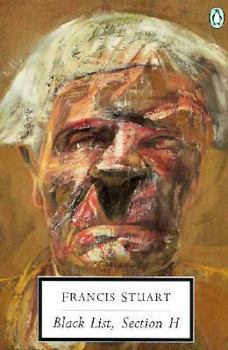Black List, Section H
Select Format
Select Condition 
Book Overview
Black List, Section H is Francis Stuart's twentieth novel, the consummation of a lifetime devoted to writing, and perhaps the keystone through which all of his other works must be viewed. Almost... This description may be from another edition of this product.
Format:Paperback
Language:English
ISBN:0140189262
ISBN13:9780140189261
Release Date:March 1997
Publisher:Penguin Group
Length:405 Pages
Weight:0.65 lbs.
Dimensions:0.8" x 5.0" x 7.7"
Customer Reviews
1 rating
My Cousin Francis Stuart
Published by Thriftbooks.com User , 27 years ago
I am intrigued by the continuing controversy over Aosdana's election to the office of Saoi of my cousin Francis Stuart, author of Black List. Francis is the cousin I didn't know I had, at least until last year. The family black sheep, the skeleton in the cupboard, he has been the family member that everyone found so hard to deal with that it was easier to deny his existence completely and since the war he has been written out of the family history, both in Burke's 1958 Landed Gentry of Ireland and in their 1978 Irish Family Records. It was not until I found the rather obscure 1930 family history "Three Hundred Years in Inishowen" by our mutual cousin Amy Young (nee Stuart) that I started to fill in the gaps and realised who he was. Francis has said (Irish Times,November 14, 1996, "Nothing But Doubt") that "the Stuart family, however, never forgave Francis's mother and blamed her for Henry's death." That's probably only a partial truth; rather, Henry's suicide shattered the family in ways that have resonated down the generations. The collective failure of the Stuart family, including, but not only, Francis, to integrate the trauma were surely a factor in the 1993 suicide of his and my cousin, travel writer Miles Clark, and so it continues. I confess I read Black List Section H at least in part neither as a literary masterpiece nor as a justification for Francis' wartime actions, but as a family history. Where he writes of how "he'd imagined his cousin Stella coming to his room at night to initiate him into the sexual mystery" I read of my godmother, later Stella Greer, who used to send me 5 quid at Christmas, and was said to be a bit of an old dragon. I presume she was the cousin whose love-letters Francis kept in the pigeon-holes of his roll-top desk at Rugby (Things to Live For (1934) ,page 17) and mentions again on the first page of Black List. And I suspect that, despite two marriages and a divorce, her cousin Francis was in some ways the unrecognised love of her life. I didn't meet her until she was eighty, but as Francis confirms, she must have been young once! The claims against Francis of anti-semitism are a malicious nonsense. Francis's biographer J.H.Natterstad (Irish Writers series, 1974) notes that "There is no evidence whatever that he saw the Jew as part of an international conspiracy or as the incarnation of evil. Although he was not sympathetic to what he saw as the Jewish obsession with money, the Jew was, as the archetypal outcast, a natural ally and was treated as such in "Julie" (written in 1938, a year before he went to Germany). Natterstad also notes that at Rugby, "There were others, he discovered, who felt themselves outsiders, and they formed their own clique, which insulated them to some extent against the life around them: 'Well, we Irish and a Jew and a Pole,' he recalled, 'we made a little group, and it was good.' " Francis has said that "I have spoken and written several million words in my life. No one could ev





